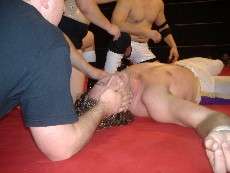Theatrics of Pain


Combat choreography is often done using explicit and implicit cooperation by all involved to minimize injuries while doing maneuvers that remain extremely dangerous. To help maintain the Willing Suspension of Disbelief, the person at the receiving end of the dangerous maneuver must appear to show that the move hurt. This is the Theatrics of Pain.
Usually, it is quite easy to tell in wrestling if someone has been injured for real or is "selling" the move by its absence. It is harder in film and television because the stuntmen (whose job it is to do all the dangerous maneuvers) are trained to handle such situations professionally in a contained environment—and such things are all behind the scene anyway.
When a wrestler pretends to be uninjured by the move, this is the Won't Work On Me. When an actor does, it is The Stoic or Made of Iron.
Sometimes, wrestlers will hit too hard. This is called "stiffness." Usually, it's harder to show any level of pain other than the true level, making them difficult to work with. That can happen in film and TV, too; we are less likely to see it there, however, because of the magic of editing.
A common place to find unscripted Theatrics of Pain is in association football (which goes by its surname "football" in most places and its nickname "soccer" in several countries). The injury is usually vaguely real, but typically so minor that even a five-year-old would laugh it off in normal circumstances. However, since injuries get penalties for the other team, and potentially get your team the advantage, many players sell even the most minor injuries with shrieks of pain, theatrical rocking, and, if possible, rivers of tears, in order to convince the referees that they're serious. Why referees haven't adopted a rule of "If you're not bleeding profusely/can't walk/can still play, you don't deserve the foul" is beyond many fans of the sport (particularly English-speaking ones; the tactic is perceived as a hallmark of non-Anglo, and specifically Latin American/European play).
Compare to Reality Is Unrealistic.
Comics
- Superman in any given media is reduced to a pain riddled heap around kryptonite. Often his anguished reaction is over-the-top in order to emphasis how painful the experience is to him as he rarely feels discomfort, never mind unspeakable agony. Interestingly one of the great criticisms of Superman is that he is either being beaten near to death or feels no pain at all. What exactly does "invulnerable" mean?
Film
- Averted in Superman II from 1980. After giving up his powers to be with Lois, Clark gets into a bar fight. His reaction to his injuries from the fight (which are admittedly minor compared to other examples here) is more shock and surprise than agony.
Professional Wrestling
- Wrestling has the most literal version; the theatrics of pain is called "selling" in that medium. Many wrestlers find themselves praised or derided based on their ability (or lack thereof) to sell an opponents attacks.
- One of the most memorable examples of a wrestler over-selling is the Shawn Michaels vs Hulk Hogan match at WWE's Summerslam 2005. You can go see here.
Theatre
- Demonstrated in Rosencrantz and Guildenstern Are Dead when Guildenstern seizes the Player's dagger and tries to stab him to death. Guildenstern thinks the Player has been Killed Off for Real, when the Tragedians start applauding and congratulating the Player on a death scene well played. (He considers his own performance "merely competent.")
Videogames
- In Punch-Out!!, especially the Wii version, boxers react in differing degrees to punches; depending on how you hit them, they'll either stand there stunned and take a flurry, take one hit and back off, or, depending on if you knock them down with a jab or a body blow, get sent flying or twirling backwards instead of merely falling over as real boxers usually do. Of course, the comical reactions are there to help the player and give them a rush from clobbering their opponent.
Western Animation
- In numerous Looney Tunes cartoons (among them An Itch In Time and Case of the Missing Hare), Bugs Bunny seriously hams it up when he is (apparently) injured.
Oh Ow! Ooh! Ouch! Oh! Oh! Agony! A-go-neeeeeeeee!
This page needs more examples. You can help this wiki by adding more entries or expanding current ones.